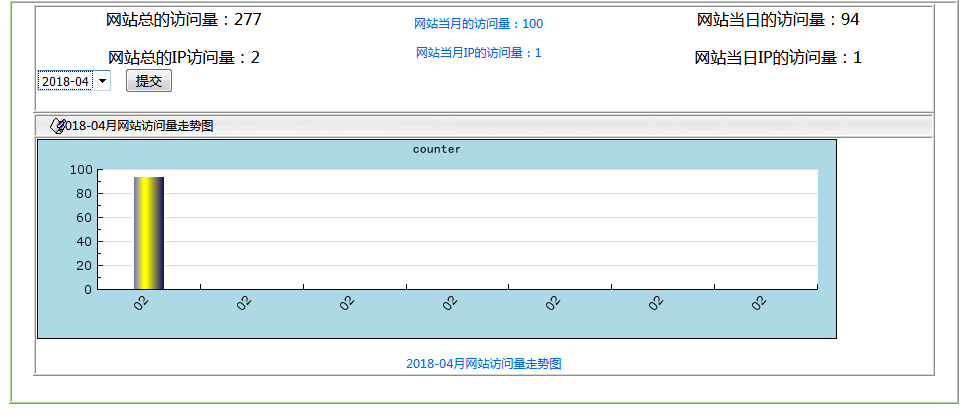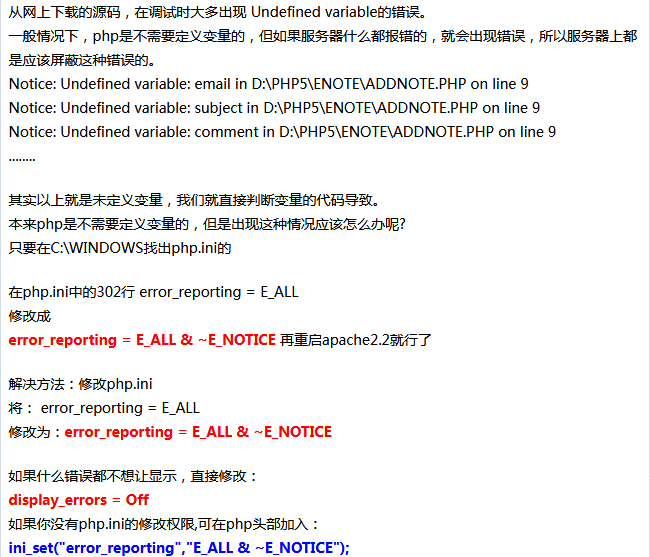网站访问量的详细分析包括网站总的访问量、总的IP访问量、网站当月访问量、网站当月IP访问量、网站当日访问量、网站当日IP访问量和网站指定月份的访问量分析图
这里两个数据库的使用没有太大的区别,只要将其中使用的MySQL数据库函数替换为SQL Server数据库函数即可。
下面仍然以使用MySQL数据库的程序为例进行介绍。网站访问量统计分析的运行结果如图1所示。

首先,连接数据库,调用指定的数据库连接文件。以及统计代码实现
<?php
$id=@mysql_connect('localhost','root',''); //连接数据库服务器
mysql_select_db('db_counter',$id); //连接db_counter数据库
mysql_query("set names gb2312"); //指定数据库中字符的编码格式
// session_start();
if(!isset($_SESSION)){session_start();}
$data1=date("Y-m-d"); //获取当前访问时间
$data2=substr(date("Y-m-d"),0,7);
$ip=getenv('REMOTE_ADDR');
$_SESSION['temp']=1; //登录以后,$_SESSION[temp]的值不为空,给$_SESSION[temp]赋一个值1
if(isset($_SESSION['temp'])){ //判断$_SESSION[temp]==""的值是否为空,其中的temp为自定义的变量
// 统计来访ip并将ip写入文件
$fp=@fopen("count.txt", "r");
$count=@fgets($fp,1024);
$count=$ip.'/';
$fp=fopen("count.txt", "w");
fputs($fp,$count);
fclose($fp);
//使用数据库存储数据
$select=mysql_query("select * from tb_count10 where data1='$data1' and ip='$ip'",$id);
$res=mysql_num_rows($select);
if($res>0){
$query1="update tb_count10 set counts=counts+1 where data1='$data1' and ip='$ip'";
$result1=mysql_query($query1);
}else{
$query="insert into tb_count10(counts,data1,data2,ip)values('1','$data1','$data2','$ip')";
$result=mysql_query($query,$id);
}
}
?>
然后,输出网站总的访问量以及总的IP访问量。步骤如下。
(1)应用SELECT语句和sum()函数,从数据表中读取counts字段总的数据,获取网站总的访问量。
<?php $query_1="select sum(counts) as countes from tb_count10 ";//查询数据库中总的访问量 $result_1=mysql_query($query_1); $countes_1=mysql_result($result_1,0,'countes'); echo "<p class='STYLE1'>网站总的访问量:$countes_1</p>";
(2)获取网站总的IP访问量。从数据表中读取数据,应用mysql_fetch_array()函数获取ip字段对应的IP地址,并将获取到的值赋给一个数组,通过array_unique()函数去除数组中重复的值,最终获取到网站总的IP访问量。代码如下:
//查询数据库中总的IP访问量
$query_2="select * from tb_count10 ";
$result_2=mysql_query($query_2);
while($myrow=mysql_fetch_array($result_2)){
$counts_2[]=$myrow[ip]; //将获取的IP的值赋给变量
}
$results_2=array_unique($counts_2); //去除数组中重复的值
$countes_2=count($results_2); //获取数组中值的数量,即总的IP访问量
echo "<p class='STYLE1'>网站总的IP访问量:$countes_2</p>";
?>
接着,获取网站当月的访问量和当月IP的访问量。使用的方法与获取网站总的访问量和总的IP访问量的方法相同。区别之处是SELECT语句中增加了一个查询条件data2='".substr (date("Y-m-d"),0,7)."',即查询数据库中符合当前月份的数据。代码如下:
<?php
//查询数据库中当月总的访问量
$query_3="select sum(counts) as countes from tb_count10 where data2='".substr(date("Y-m-d"),0,7)."'";
$result_3=mysql_query($query_3);
$countes_3=mysql_result($result_3,0,'countes');
echo "<p class='STYLE2'>网站当月的访问量:$countes_3</p>";
//查询数据库中当月的IP访问量
$query_4="select * from tb_count10 where data2='".substr(date("Y-m-d"),0,7)."'";
$result_4=mysql_query($query_4);
$counts_4=array();
while($myrow_4=mysql_fetch_array($result_4)){
$counts_4[]=$myrow_4[ip]; //将获取的IP的值赋给变量
}
$results_4=array_unique($counts_4); //去除数组中重复的值
// 统计来访ip并写入文件
foreach($results_4 as $key=>$value){
$fp=@fopen("$data2".".txt", "r");
$count=@fgets($fp,1024);
$count=$value.'/';
$fp=fopen("$data2".".txt", "w");
fputs($fp,$count);
fclose($fp);
}
$countes_4=count($results_4); //获取数组中值的数量,即总的IP访问量
echo "<p class='STYLE2'>网站当月IP的访问量:$countes_4</p>";
?>
获取网站当日的访问量和当日的IP访问量。其使用的方法这里不再赘述,指定的查询条件是data1='".date("Y-m-d")."'。程序关键代码如下:
<?php
//查询数据库中当日总的访问量
$query_5="select sum(counts) as countes from tb_count10 where data1='".date("Y-m-d")."' ";
$result_5=mysql_query($query_5);
$countes_5=mysql_result($result_5,0,'countes');
echo "<p class='STYLE3'>网站当日的访问量:$countes_5</p>";
//查询数据库中当日的IP访问量
$query_6="select * from tb_count10 where data1='".date("Y-m-d")."'";
$result_6=mysql_query($query_6);
$counts_6=array();
while($myrow_6=mysql_fetch_array($result_6)){
$counts_6[]=$myrow_6[‘ip’]; //将获取的IP的值赋给变量
}
if(is_array($counts_6)){
$results_6=array_unique($counts_6); //去除数组中重复的值
// 统计来访ip并写入文件
foreach($results_6 as $key=>$value){
$fp=@fopen("$data1".".txt", "r");
$count=@fgets($fp,1024);
$count=$value.'/';
$fp=fopen("$data1".".txt", "w");
fputs($fp,$count);
fclose($fp);
}
$countes_6=count($results_6); //获取数组中值的数量,即总的IP访问量
echo "<p class='STYLE3'>网站当日IP的访问量:$countes_6</p>";
}
?>
最后,创建一个form表单,实现对指定月份的网站访问量进行折线图分析。步骤如下。
(1)创建一个form表单,用于提交月份信息。将数据提交到本页,设置变量的名称为select。代码如下:
<form name="form1" method="post" action="index.php">
<select name="select">
<?php
$que="select distinct data2 from tb_count10";
$res=mysql_query($que,$id);
while($myrow=mysql_fetch_array($res)){
?>
<option value="<?php echo $myrow['data2'];?>"><?php echo $myrow['data2'];?></option>
<?php
}
?>
</select>
<input type="submit" name="Submit" value="提交">
</form>
2)编写PHP语句,从数据库中读取出指定月份内网站访问量的数据,并且对该数据以逗号(“,”)进行分隔,存储到变量中。代码如下:
<?php
if(isset($_POST['select'])){ //判断提交的数据是否为真
$query="select counts,data1 from tb_count10 where data2='".$_POST['select']."' order by data1 "; //定义SQL语句
$result=mysql_query($query); //执行查询语句
$results=array(); //定义数组
$datas=array(); //定义数组
while($myrow=mysql_fetch_array($result)){ //循环输出查询结果
$results[]=$myrow['counts']; //将查询结果存储到数组中
$lmbs=implode(",",$results); //将数组重新生成一个字符串
$datas[]=substr($myrow['data1'],8,2); //截取时间数据,并存储到数组中
$das=implode(",",$datas); //将数组重新生成一个字符串
}
?>
(3)接着,插入一个图片,指定图片的路径为stat.php文件,设置链接标识为从数据库中读取出的指定月份内网站访问量的数据($lmbs)。代码如下:
<table width="902" border="1" cellpadding="1" cellspacing="1" bordercolor="#FFFFFF" bgcolor="#D5D5D5">
<tr>
<td height="18" background="images/mysql_9.jpg" bgcolor="#FFFFFF" class="STYLE4"> <?php echo $_POST['select'];?>月网站访问量走势图</td>
</tr>
<tr>
<td bgcolor="#FFFFFF">
<p><img src="stat.php?lmbs=<?php echo $lmbs; ?>&das=<?php echo $das;?>"/></p>
<p align="center" class="STYLE2"><?php echo $_POST['select'];?>月网站访问量走势图</p>
</td>
</tr>
</table>
<?php
}
?>
树状图生成用Jpgraph,只要了解它的一些内置函数,可以轻松得画出折线图、柱形图、饼状图等图表。
1.首先要保证PHP打开了Gd2的扩展:
2.打开PHP.ini,定位到extension=php_gd2.dll,把前面的分号删掉。
3.然后下载Jpgraph,download.chinaunix.net/download.php?id=35443&ResourceID=5098,解压到一个文件夹中。如 E:Softwarewebwwwjpgraph。
4.最后附上生成代码
<?php
include ("src/jpgraph.php"); //载入类库文件
include ("src/jpgraph_bar.php");
$lmbs=$_GET['lmbs']; //获取超级链接传递的参数值
$das=$_GET['das'];
$datay=explode(",",$lmbs); //按照","分隔字符串 $data为获取的数据变量
$datax=explode(",",$das); //按照","分隔字符串 $data为获取的数据变量
$graph = new Graph(800,200,"auto"); //创建图像
$graph->img->SetMargin(60,20,30,50); //设置图像边框间距
$graph->SetScale("textlin"); //定义坐标刻度类型
$graph->SetMarginColor("lightblue"); //定义图像颜色
$graph->title->Set('counter'); //定义标题
$graph->title->SetFont(FF_SIMSUN, FS_BOLD); //设置标题字体
$graph->xaxis->SetFont(FF_VERDANA,FS_NORMAL,10); //设置X轴的字体
$graph->yaxis->SetFont(FF_VERDANA,FS_NORMAL,10); //设置Y轴的字体
$graph->xaxis->SetTickLabels($datax); //设置X轴输出的数据
$graph->xaxis->SetLabelAngle(50); //设置输出文字大小
$bplot = new BarPlot($datay); //实例化图像创建类
$bplot->SetWidth(0.3); //设置柱形图的输出大小
$bplot->SetFillGradient("navy","#FFFF00",GRAD_LEFT_REFLECTION); //设置图像的类型和填充颜色
$bplot->SetColor("white"); //设置图像边框颜色
$graph->Add($bplot); //添加数据
$graph->Stroke(); //生成图像
源代码打包:网站统计代码
报错Notice: Undefined variable: 的解决方法
